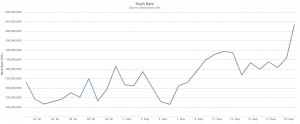Where is all that hashing power coming from? The most likely source is a new wave of “hashing centers,” industrial-scale bitcoin mining facilities with thousands of machines grinding away in an attempt to solve the next block. Often built in warehouses and former factory floors, the centers can bring millions of dollars in bitcoin hardware online in a matter of weeks. Unlike traditional data centers, where uptime and maintenance is a major concern, hashing centers simply need a large space, a decent cooling strategy, affordable electricity rates and a supply of powerful hardware to become profitable. Several major hashing centers have opened in recent months, and today’s spike appears to be the result of at least one new center coming online.
What does this mean for the greater bitcoin community? Generally speaking, the more difficult a bitcoin is to mine, the higher the price of bitcoin tends to rise. If the average cost to mine a bitcoin rises to $1000, for instance, few miners would be willing to sell at a loss. So either miners drop out, lowering the hashrate and the difficulty, or the price goes up because the supply of sub-$1000 coins rapidly decreases.
For hobbyist miners, the increase generally results in a loss of revenue with existing equipment. That said, with the arms race to create the most efficient, profitable mining rigs hotter than ever, this also means that extraordinarily powerful mining hardware — the same kind used by the hashing centers — is now more available and affordable than ever before. In that respect, today’s massive hashrate spike and its implications are nothing new small-scale miners who are used to investing some of their profits in ongoing upgrades.
One thing isn’t yet clear: Just how high will the ultimately hashrate climb today?














